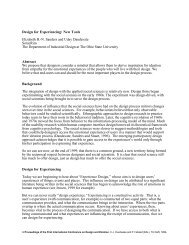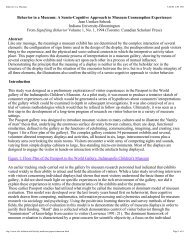: Interface as Content The Construction of Experience - ec(h)o
: Interface as Content The Construction of Experience - ec(h)o
: Interface as Content The Construction of Experience - ec(h)o
You also want an ePaper? Increase the reach of your titles
YUMPU automatically turns print PDFs into web optimized ePapers that Google loves.
David Rokeby : Transforming Mirrors3/11/03 4:21 PMfrom my experience creating and exhibiting interactive systems. At first glance, it may seem that I’mstretching the point here. It’s really just entertainment, right? Indeed, <strong>as</strong> an artist, it’s my traditionalright to use every trick in the book to create a magical experience. Fant<strong>as</strong>y and illusion are keyelements <strong>of</strong> most eff<strong>ec</strong>tive culture, from high-brow theatre to video games. Hollywood h<strong>as</strong> alwaysrelied on sets, stunt people, and sp<strong>ec</strong>ial eff<strong>ec</strong>ts to get its stories across. Computer gamedevelopers are the newest m<strong>as</strong>ters <strong>of</strong> illusion.One <strong>of</strong> the clearest examples I can r<strong>ec</strong>all is an early videodisc-b<strong>as</strong>ed video game in which usersgot the impression that they were flying at great speed over a terrain. <strong>The</strong> videodisc w<strong>as</strong> made up <strong>of</strong>video clips which linked together in a branching and merging structure. <strong>The</strong> image I saw on thescreen w<strong>as</strong> the middle portion <strong>of</strong> the full video frame. If I turned to the left during a linear videosegment, the s<strong>ec</strong>tion <strong>of</strong> the frame that I saw instantly panned in that dir<strong>ec</strong>tion, giving an immediatesense <strong>of</strong> responsiveness, but I w<strong>as</strong>, in fact, still travelling along the same restricted path. <strong>The</strong>illusion that I had the freedom to roam the entire terrain w<strong>as</strong> maintained for a surprisingly long time,partly b<strong>ec</strong>ause I w<strong>as</strong> moving at a high ‘virtual’ speed without time to refl<strong>ec</strong>t on the degree to whichmy actions were being refl<strong>ec</strong>ted. That t<strong>ec</strong>hnique w<strong>as</strong> a brilliant and eff<strong>ec</strong>tive way to get around theinherent limitations <strong>of</strong> videodisc <strong>as</strong> a real-time interactive medium. Whether you really had freedomto wander the terrain w<strong>as</strong> beside the point, b<strong>ec</strong>ause the game w<strong>as</strong> engaging and exciting.<strong>The</strong> line between entertainment and everything else is getting very vague these days(infotainment, edutainment). <strong>The</strong> Web represents a convergence <strong>of</strong> the video game industry andcommercial transaction systems, and this leads to a potential problem; illusion translated into th<strong>ec</strong>ommercial world b<strong>ec</strong>omes d<strong>ec</strong>eption. <strong>The</strong> tricks <strong>of</strong> today’s artists and hackers are the commercialtools <strong>of</strong> tomorrow. Perhaps more significantly, with the explosive growth <strong>of</strong> the internet, thesesleights-<strong>of</strong>-hand are b<strong>ec</strong>oming incorporated into communications systems, and by implication, intoour social fabric. Whether we intend it or not, we’re redesigning the ways that we experience theworld and each other.VIRTUAL SPILL<strong>The</strong>re are two levels <strong>of</strong> leakage here. On one level, there is the effortless migration <strong>of</strong> code andhardware from the entertainment world to the “serious” worlds <strong>of</strong> commerce, justice, andcommunication. At the s<strong>ec</strong>ond level, artificial experiences subtly change the way we feel, perceive,interpret, and even describe our “real” experiences.<strong>The</strong> most graphic and extreme example <strong>of</strong> virtual spill into the real is probably VR-sickness, anafter-eff<strong>ec</strong>t <strong>of</strong> Virtual Reality. My experience w<strong>as</strong> that I would suddenly lose my orientation in spaceat apparently random moments for about 24 hours after my virtual immersion. I felt <strong>as</strong> though I were<strong>of</strong>f the floor, and at an unexp<strong>ec</strong>ted angle. As far <strong>as</strong> I can tell, the explanation w<strong>as</strong> that, when I w<strong>as</strong>immersed, I’d desensitized my response to the balancing m<strong>ec</strong>hanisms in my inner ears in order tosustain the illusion <strong>of</strong> motion in a purely visually defined 3D space. Once I w<strong>as</strong> desensitized, I w<strong>as</strong>free to accept the illusion <strong>of</strong> space that the VR system provided. But on returning to “real” space,my inner ears didn’t immediately resume their job. I w<strong>as</strong> taking my sense <strong>of</strong> orientation in spaceentirely from visual cues. One attack may have been stimulated by a design <strong>of</strong> sharply angled linespainted on a wall. My visual system seems to have interpreted this cue <strong>as</strong> vertical, and abruptlychanged its mind about my body’s orientation, while my ears were certain that I w<strong>as</strong> standing quitestraight, bringing on a wave <strong>of</strong> nausea.I’ve also experienced after-eff<strong>ec</strong>ts from spending extended periods interacting with my mostexhibitedinteractive installation, Very Nervous System. In this work, I use video camer<strong>as</strong>, anhttp://www.interlog.com/~drokeby/experience.htmlPage 2 <strong>of</strong> 15





